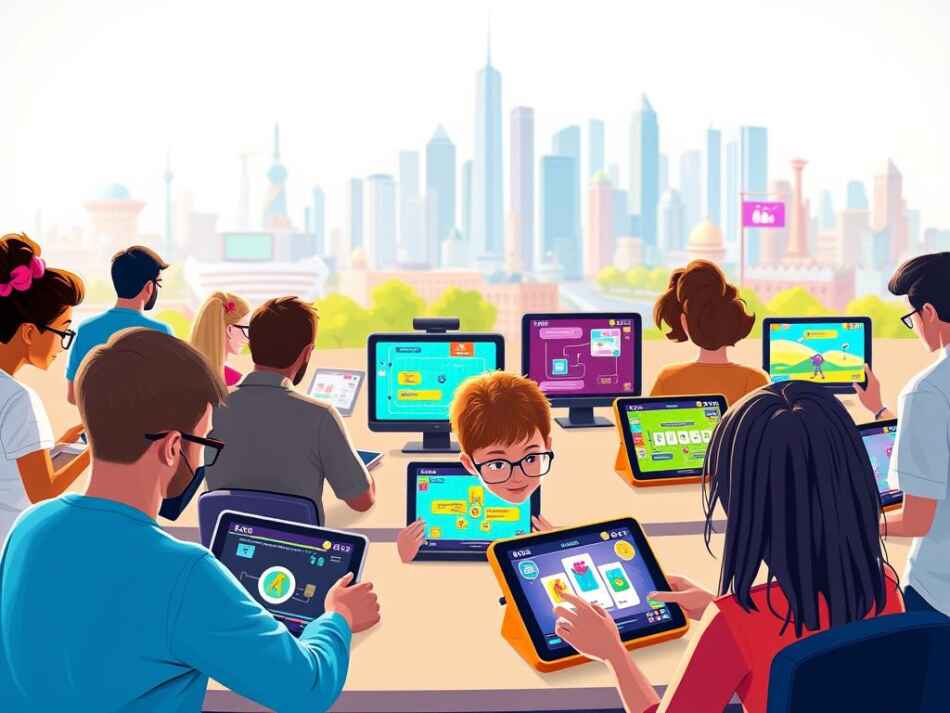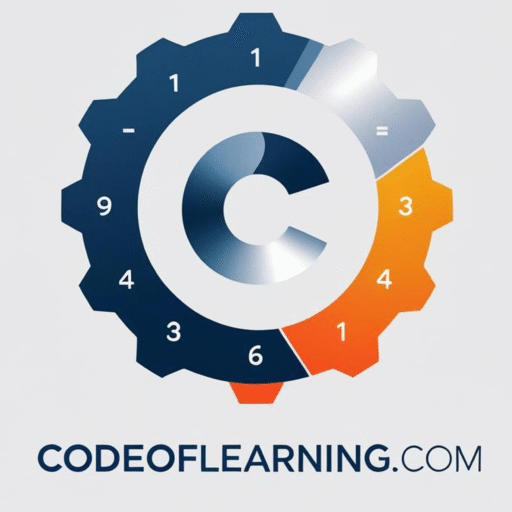The tech world is changing fast, and developers must keep up. In 2025, the best tools to learn coding have changed a lot. Now, learning skills is easier than ever.
AI assistants are like virtual teachers, helping programmers understand tough ideas. They also create solutions to common problems. These smart systems find mistakes quickly and offer tips to improve.
Developers today focus more on solving real problems. They spend less time on basic coding. Modern programming tools do the boring stuff for them. This lets them think creatively and come up with new ideas.
Whether you’re new to coding or have been doing it for years, 2025 has great resources for you. This guide will show you the top platforms, interactive tools, and AI helpers. They are changing how we learn technical skills in our fast-changing digital world.
Introduction to Coding Learning Tools
In today’s fast-changing tech world, coding tools are key for developers to grow. The tech scene in 2025 is full of new challenges and chances. These tools help programmers keep up by learning new skills.
Developers now use more than just code editors and version control. They have interactive learning platforms, apps, and community resources. These help everyone learn, no matter their skill level or goals.
Importance of Learning Tools for Developers
Technology changes fast, so developers must keep learning. What was new a few years ago is now old. Learning tools help programmers stay current and build their skills.
For newbies, these tools make learning easier. They break down hard topics into simple parts. They also give feedback right away to help you learn better.
For experienced developers, coding platforms let them try new things. They can learn without stopping their current work.
The right tools can help you learn faster in many ways:
- They fill knowledge gaps with exercises
- They teach new ideas through doing
- They help you learn by repeating and getting feedback
- They make you better at solving problems
- They let you work with other programmers
Overview of Available Resources
There are many learning tools for developers now. They fit different learning styles and goals. Knowing what’s out there helps you pick the best tools for you.
Online platforms are very popular. They mix learning with doing, so you can practice right away. They also have built-in editors that make starting easy and give feedback fast.
Mobile apps are great for learning on the go. They offer short lessons and fun challenges. This makes learning fun and helps you build skills little by little.
Coding bootcamps and intensive programs offer deep learning. They focus on practical skills and have mentors. These programs are for those who want to dive deep into coding.
Community resources like forums and open-source projects are also important. They let developers learn from real projects and get feedback from others. This is a great way to learn from others and grow.
As we look at different tools, think about how they fit your learning style and goals. The best plan often uses many tools together. This way, you can learn what you need now and for the future.
Online Coding Platforms
In 2025, online coding platforms are key for developers to improve their skills. They offer interactive exercises, community support, and detailed curricula. This mix helps developers learn effectively.
The best platforms balance teaching and doing. This way, developers can apply what they learn in real jobs. Let’s look at three top platforms that help developers learn and practice.
Codecademy: Interactive Coding Lessons
Codecademy teaches programming in a fun, interactive way. It gives feedback as you code. This method keeps developers engaged through hands-on exercises.
Codecademy is special in 2025 because it keeps up with new tech. It now has tracks in artificial intelligence, blockchain development, and quantum computing. This helps developers stay relevant.
For newbies, Codecademy has clear steps to learn. More advanced developers get modules to fill gaps. The platform offers:
- Peer code reviews for feedback
- Interactive projects that mimic real jobs
- Skill assessments to find learning gaps
- Community forums for solving problems together
freeCodeCamp: Project-Based Learning
freeCodeCamp is known for its focus on projects and free learning. It takes learners from basic HTML to advanced JavaScript. It’s a free path to learning.
Its strength is in practical learning. Each certification requires many projects. This shows developers can apply what they learn.
Many employers now recognize freeCodeCamp certifications. The community helps new developers with:
- Code reviews on projects
- Local study groups
- A big library of articles
- Regular coding challenges
LeetCode: Problem-Solving for Competitive Coders
LeetCode is top for tech interviews and coding challenges. It has over 1,500 problems for all levels. It’s great for improving coding skills.
LeetCode focuses on solving problems efficiently. It lets developers try different solutions and see how they compare. This is useful for real jobs where speed matters.
The forums are full of tips on solving problems. After solving a challenge, you can see how others did it. LeetCode’s features include:
- Weekly contests that feel like interviews
- Problem sets for specific companies
- Difficulty ratings to track progress
- Analytics to find areas to improve
These platforms are among the best tools to learn coding in 2025. They offer different ways to learn, depending on your goals. Whether you like Codecademy’s interactive lessons, freeCodeCamp’s projects, or LeetCode’s challenges, these platforms help you grow.
Mobile Coding Apps
Today, beginner coders use mobile apps for learning. These apps make learning to code easy and fun. They fit into busy lives, making learning to code easy.
Mobile apps have changed how we learn to code. They let us learn during breaks or on the go. This is great for people who work and want to learn tech skills.
SoloLearn: Learn on the Go
SoloLearn is a top choice for mobile coding. It offers bite-sized learning modules for easy learning. This is perfect for beginner coders who get lost in long tutorials.
SoloLearn has a cool code playground. It lets users practice coding right in the app. This makes learning fun and hands-on.
The app also has a strong community. Users can:
- Share code snippets for feedback
- Participate in coding challenges
- Engage in peer-to-peer discussions
- Celebrate achievements with fellow developers
SoloLearn makes learning fun with badges and leaderboards. It turns learning into a game, keeping users motivated.
Mimo: Coding Games and Challenges
Mimo teaches coding through games. It’s great for those who learn by doing. The app makes coding puzzles that get harder as you progress.
Mimo has clear learning paths for different goals. It offers tracks for web development, data science, and more. Each track has projects that build skills step by step.
For beginners, Mimo has great onboarding. It explains programming basics and gives feedback on exercises. It also introduces technical terms slowly.
Mimo’s coding kits are special. They focus on specific challenges or projects. These kits let learners try different coding areas without committing to long courses.
SoloLearn and Mimo have changed coding education. They offer practice and reinforcement that fits into our busy lives. For beginner coders, these apps are great for starting and staying interested in coding.
Coding Bootcamps and Intensives
In 2025, coding bootcamps are key in the tech world. They offer fast learning for developers. Unlike long college degrees, bootcamps give quick, hands-on training for the job market.
Today, coding bootcamps are top choices for learning to code. They mix tough lessons with real-world projects and industry ties. This makes them great for those wanting to learn fast without long studies.

General Assembly: Full Immersion Experience
General Assembly leads in immersive bootcamps. By 2025, they’ve added new tech like AI and quantum computing. Their programs match today’s tech jobs.
General Assembly focuses on doing real projects. Students work on big projects with real-world challenges. This helps them learn by doing, not just reading.
- Portfolio-ready projects that show employers what you can do
- Use of the latest programming tools and methods
- Learning to work with others on projects
- Getting feedback from tech pros
- Meeting future employers
GA’s strong ties with employers help students find jobs fast. They place 91% of graduates in jobs within six months. Students also see a 43% pay rise after the program.
Flatiron School: Tailored Coding Education
Flatiron School offers learning plans that fit each student. They start with a detailed check to see what you know and want to learn. Then, they create a plan just for you.
They pair students with mentors for support. Mentors give feedback, advice, and help with projects. They also help with career plans and networking.
- Weekly one-on-one code reviews and feedback sessions
- Personalized project guidance and technical advice
- Career strategy consultations
- Industry insights and networking opportunities
- Emotional support during the intensive learning process
Flatiron focuses on practical skills. Students build real apps using programming tools used in the field. This leads to a 93% job rate, with an average salary of $74,000.
Thinking about bootcamps? They cost $15,000 to $20,000 for 3-6 months. Part-time options last 9-12 months, allowing you to work while learning.
Many find bootcamps worth it. They lead to better jobs and higher pay. For those ready to dive into coding, bootcamps are a fast track to success in 2025.
Interactive Coding Environments
Browser-based coding platforms have changed how we learn to code. They create spaces where developers can work together and share projects right away. These platforms make it easy to start coding without worrying about setting up software.
They also use AI to help learn, making them essential tools for modern developers.
In 2025, these environments are key for learning and working. They let developers try new things without setting up their own spaces. This makes learning faster.
Replit: Collaborative Coding Platform
Replit is a top cloud-based IDE that focuses on teamwork and easy access. It lets many developers work on the same code at the same time. This is great for team projects and learning together.
Replit’s instant deployment capability is a big plus. Developers can see their code work right away. This helps beginners see how their code affects the output.
The platform also has a strong community. Users can share projects, learn from others, and get help. Replit’s AI helps with coding, suggesting better ways to write code.
Glitch: Build and Remix Web Apps
Glitch focuses on remixing projects to learn. It lets beginners start with working code and see how it works. By 2025, Glitch will have many projects to remix.
Glitch makes it easy to start coding without worrying about setup. It’s great for beginners and experienced developers alike. It has powerful capabilities for complex projects.
Glitch also helps teams work together in real-time. It now checks code for bugs and security issues. This helps developers write better code from the start.
Replit and Glitch have changed how we learn and work. They help developers move from learning to working smoothly. As they grow, they make learning and working easier and more connected.
Video Tutorial Websites
Video tutorial platforms are key in coding education. They mix visual learning with hands-on practice. By 2025, they’ve grown from simple videos to full learning systems. This is great for beginner coders because they can understand complex ideas better.
Today’s video sites have cool features like interactive lessons and projects. They also have community areas. This makes learning fun and helps learners grow from basics to advanced skills. They are among the best tools to learn coding today.
Udemy: Diverse Course Offerings
Udemy is a top place for coding lessons. It has thousands of teachers for all programming areas. This means learners can find the right course for their needs, like Python or quantum computing.

Udemy is known for its good ratings and reviews. Students can see which courses are top-notch. This helps new learners find the best content.
Udemy’s learning is flexible and smart. It adjusts to how fast you learn. Courses include:
- Interactive coding exercises in video lessons
- Real-time feedback on code
- Project-based tests like real jobs
- Forums for support and networking
- Downloadable study materials
Udemy is great for those with busy lives. It lets you learn at your own pace, fitting into your schedule.
Coursera: University Partnerships for Learning
Coursera works with top universities and tech companies. It offers deep learning in coding. This mix of university theory and industry know-how is powerful.
Coursera’s specializations and certificates are well-liked by employers. By 2025, many jobs will look for people with Coursera skills. This shows the platform’s high standards and thorough learning plans.
Coursera’s group learning model helps learners stay connected. They work together, doing:
- Discussions with university teachers
- Peer-reviewed tasks to improve feedback skills
- Team projects like real teams
- Challenges from industry leaders
- Networking with others
Coursera uses AI to make learning personal. It finds what you need to work on and suggests ways to improve. This helps learners get better faster.
Udemy and Coursera have built-in coding tools. This makes learning smooth and keeps learners focused.
For beginner coders, these sites offer a clear start into coding. They show ideas in a simple way. With expert help, practice, and support, they are the best tools to learn coding for newbies.
Community and Forum Support
Coding forums and community platforms are key for developers. They help improve skills as programming changes fast. These places are where coders get help, share knowledge, and meet others with similar challenges.
Today’s developers use these communities to learn more. They get help from millions of programmers worldwide. This helps them solve problems and learn new coding ideas.
Stack Overflow: Q&A Resource for Developers
Stack Overflow is top for programmers with tech problems. It has over 21 million questions and 31 million answers. Its reputation-based system rewards good answers.
Stack Overflow is great for all developers. Beginners learn basics, and experts find answers to tough problems. It supports new tech like AI and quantum computing.
Stack Overflow also helps developers talk better. They learn to explain tech clearly. Employers see a good Stack Overflow profile as a sign of skill and teamwork.
GitHub: Collaboration and Project Showcases
GitHub is more than a version control tool. It’s a key place for learning and showing off projects. It has over 200 million repositories.
Looking at GitHub projects shows how pros code. It teaches about big apps, design patterns, and solving problems. This helps bridge the gap between theory and practice.
GitHub’s features help beginners learn from others. They get feedback on their code. This helps them grow and make professional connections.
GitHub is also where tech companies find talent. A good GitHub profile shows a developer’s skills and teamwork. Many developers find jobs through GitHub.
Platforms like GeeksforGeeks also help. They offer learning paths and forums. This creates a full learning environment where theory and practice meet.
The best developers in 2025 are active in these communities. They don’t just get information; they give back. This helps them grow both technically and personally. These resources are key as programming tools keep changing.
Gamification in Learning Tools
In 2025, gamified learning tools are key in coding education. They make learning fun and effective. Game mechanics in educational platforms turn practice into engaging challenges.
These tools use points, badges, and stories to keep learners interested. They are great for visual learners and those who find programming hard.
CodeCombat: Learning Through Gameplay
CodeCombat turns coding into a role-playing game. Players write code to control characters in challenges. It’s different from traditional tutorials.
The game makes programming concepts real through visual feedback. If a player writes a loop wrong, they see it right away. This helps learners understand better than text-based learning.
CodeCombat introduces new concepts slowly. It keeps learners engaged with stories and achievements. Beginners start with simple commands and learn more as they go.

CodinGame: Competitive Coding Challenges
CodinGame focuses on solving problems competitively. It presents challenges as games where developers compete. This taps into their competitive spirit.
The platform has tournaments and leaderboards. Players can see their code in action in multiplayer games. This makes them want to improve their coding.
CodinGame offers challenges in over 25 programming languages. It’s good for both beginners and experienced developers. It helps developers become versatile in solving problems.
By 2025, CodinGame will have AI opponents that adjust to each player’s skill. These AI systems analyze coding patterns and offer challenges that are just right for learning.
These gamified platforms are valuable because they make skills useful in real life. Studies show that beginner coders who learn this way do better than those who don’t. The fun format makes learning stick.
For those scared of coding, these platforms are a good start. They build confidence and skills. Many professional developers say these tools helped them start their careers.
Trends in Coding Education for 2025
Coding education is changing fast, thanks to AI. Old ways of learning are being replaced by new, better systems. These changes are big, not just small tweaks.
Today’s coding platforms use AI to help learners. They make learning paths that fit each person better. This change is happening at all levels, from beginners to pros.
The Rise of Artificial Intelligence in Learning Tools
AI has grown from simple tools to smart partners in coding. Now, AI in programming tools gives suggestions that get what you’re trying to do. It knows your coding style too.
AI can spot bugs before you run the code. It suggests better ways to design and even finds faster algorithms. It’s doing things we couldn’t imagine a few years ago:
- It checks your code for mistakes and security issues right away
- It understands what you mean in plain English
- It creates tests based on how your code works
- It helps with web, data science, and mobile app coding
- It works with version control to suggest improvements
AI is getting better at different coding areas. It knows what’s hard for data visualization and mobile app coding. It gives advice that fits each area well.
Personalized Learning Experiences and AI
AI is making learning more personal. Coding platforms now look at how you code. They find what you know and what you need to learn.
These systems make learning harder or easier as needed. They keep you in the right learning zone. This keeps learning fun and effective.
AI makes learning personal in many ways:
- It uses spaced repetition to help you remember
- It gives you practice that’s like real-world coding
- It tracks your progress to see what you need to work on
- It learns how you learn best and shows you things in your style
- It suggests projects that match your goals and interests
But, we need to make sure AI doesn’t replace learning basics. The best programming tools keep humans involved. They help you solve problems on your own.
Leaders are working to find the right mix of AI and human skills. They want AI to help, not do everything. The goal is to let humans think deeply while AI handles the rest.
As we get closer to 2025, AI will play an even bigger role in coding education. The way we learn will keep changing. It will become more personal, efficient, and meet our needs better.
Conclusion: Choosing the Right Tools
Learning to code needs the right tools and approach. With many resources for beginner coders, finding what works for you is key.
Assessing Personal Learning Styles
Everyone learns differently. Visual learners might like video tutorials on Udemy or Coursera. Hands-on learners do well with Replit or CodeCombat.
Social learners might enjoy Stack Overflow or GitHub projects. Think about how you learned best before. Did you learn from reading, watching, or doing? Knowing this helps you choose the best tools.
Building a Continuous Learning Habit
Being consistent is more important than trying to learn too much at once. Set goals, like mastering JavaScript or making a web app. Break these goals into small tasks for your daily schedule.
Use a mix of tools for learning. Courses for basics, problem-solving platforms, and projects for applying what you learn. Many coders pair theory with practice.
Keep track of your progress with journals or GitHub. Celebrate your small wins to stay motivated. Remember, even pros keep learning.
The best skill in tech is knowing how to learn. With the right tools and consistent practice, you’ll grow in this changing field.

